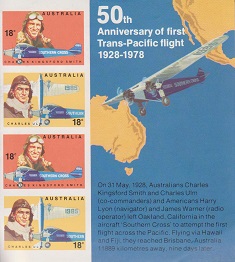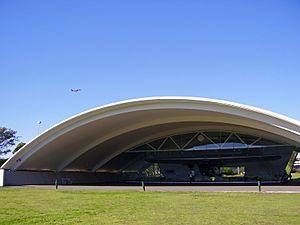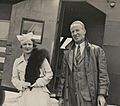Charles Kingsford Smith facts for kids
Quick facts for kids
Charles Kingsford Smith
|
|
|---|---|
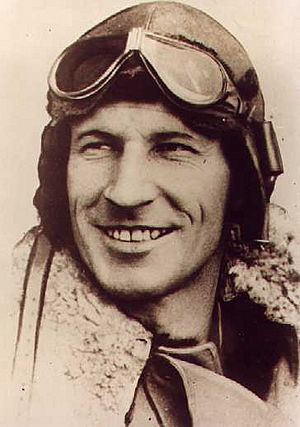
Kingsford Smith in his flying gear
|
|
| Born | 9 February 1897 Brisbane, Queensland, Australia
|
| Died | 8 November 1935 (aged 38) |
| Cause of death | Crashed in the sea off Burma |
| Nationality | British subject Australian |
| Known for | First non-stop crossing of the Australian mainland Trans-Pacific flight England to Australia air race |
| Awards | Knight Bachelor Military Cross Air Force Cross Segrave Trophy |
| Aviation career | |
| Full name | Charles Edward Kingsford Smith |
| Air force | Australian Flying Corps Royal Flying Corps Royal Air Force |
| Battles | World War I |
| Rank | Captain (substantive) Air Commodore (honorary) |
Sir Charles Edward Kingsford Smith (born February 9, 1897 – died November 8, 1935) was a famous Australian aviator. People often called him Smithy. He became known around the world in 1928. This was when he made the first flight across the Pacific Ocean from the United States to Australia.
Smithy also achieved many other amazing flights. He was the first to fly non-stop across Australia. He also made the first flights between Australia and New Zealand. Plus, he flew from Australia to the United States across the Pacific. He even set a new record by flying from Australia to London in just 10 and a half days!
Contents
Early Life
Charles Kingsford Smith was born in Hamilton, Brisbane, Australia. This was on February 9, 1897. Brisbane is the main city of Queensland. He went to school in Sydney.
When he was 16, Smithy started an apprenticeship. He worked at a sugar company. There, he learned about engineering, which is how things are designed and built.
Military Career
In 1915, Smithy joined the 1st Australian Imperial Force (AIF). This was Australia's main army group during World War I. He worked as a sapper, building and fixing roads and bridges. He also delivered important messages on a motorcycle.
In 1916, he moved to the Royal Flying Corps (RFC). There, he became a pilot. In 1917, Smithy's plane was shot down during a battle. He survived, but he was injured. Part of his left foot had to be removed by surgery.
He received the Military Cross for his bravery. Because of his injuries, Smithy became an RFC flying teacher. He was also promoted to Captain. In April 1918, he joined the new Royal Air Force.
After the war, in 1919, Smithy started a company. It offered "joy-riding" services. This meant people could pay to go for a ride in his plane. He mostly flew in England. Later, he worked in the United States. He was a "barnstormer," doing airplane tricks to entertain crowds.
In 1921, he came back to Australia. He continued barnstorming and also delivered airmail. On June 2, 1921, Smithy got his commercial pilot's license. He became one of Australia's first airline pilots. He flew for West Australian Airways.
On June 6, 1923, Smithy married Thelma Eileen Hope Corboy.
Famous Flights
Smithy became very famous for setting flying records. He was known all over the world for his amazing flights. Here are some of his most famous journeys:
- Flying around Australia: In 1926, he flew around Australia with C T P Ulm. They did it in 10 days and 5 hours. This was twice as fast as anyone else had flown around Australia before!
- First Trans-Pacific Flight: He flew across the Pacific Ocean with three other people. They started in California and landed in Hawaii. Next, they flew from Hawaii to Fiji. This part was very hard because of bad storms. Finally, they flew from Fiji to Brisbane. When they landed in Brisbane, 25,000 people were there to cheer for them! Then they flew to Sydney, where 300,000 people greeted them.
- First Flight Around the World: Smithy and his team completed the first-ever flight around the world. They flew to England, then across the Atlantic Ocean to North America, and finally to California.
- Solo Long-Distance Flight: He flew 10,000 miles all by himself.
In the same year as his 10,000-mile flight, Smithy married Mary Powell. They had a son named Charles.
Disappearance and Death
Sir Charles Kingsford Smith and his co-pilot, John Thompson "Tommy" Pethybridge, were flying the Lady Southern Cross. They were trying to break a speed record from England to Australia. On November 8, 1935, they disappeared over the Andaman Sea. This happened during the night flight from Allahabad, India, to Singapore.
A search for them lasted 74 hours. But their bodies were never found. About 18 months later, fishermen found a landing gear leg and wheel. It had washed ashore at Aye Island in Burma. The Lockheed company confirmed it was from the Lady Southern Cross. Experts believe the plane is near the island, about 15 fathoms deep. This landing gear leg is now on display at the Powerhouse Museum in Sydney, Australia.
In 2009, a filmmaker named Damien Lay said he was sure he had found the Lady Southern Cross. His search was in the same area where the landing gear was found in 1937.
Kingsford Smith's wife, Mary, and their three-year-old son, Charles Jnr., survived him. His life story, My Flying Life, was published after his death in 1937. It became a very popular book.
Honours and Legacy
Kingsford Smith was made a Knight Bachelor in 1932. This means he was given the title "Sir" for his great work in aviation. He also became an honorary Air Commodore in the Royal Australian Air Force.
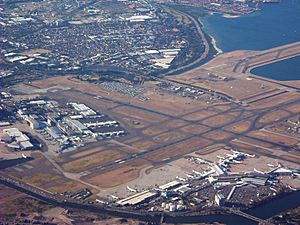
Sydney's main airport is named Kingsford Smith International Airport in his honour. A part of Sydney and a school in Canberra are also named after him. There is also a school in Vancouver, Canada, named after him.
His most famous airplane, the Southern Cross, is now kept in a special memorial. It is at Brisbane Airport. Kingsford Smith sold the plane to the Australian Government in 1935. He wanted it to be shown to the public forever.
Kingsford Smith was pictured on the Australian $20 paper money from 1966 to 1994. He was also on the Australian one-dollar coin in 1997. This was to celebrate 100 years since his birth.
A park in Suva, Fiji, has the Kingsford Smith Pavilion. This is where he landed during his trans-Pacific flight. A memorial stands at Seven Mile Beach (New South Wales). It remembers the first commercial flight to New Zealand.
Qantas named one of its large planes, an Airbus A380, after Kingsford Smith. KLM also named one of its Boeing 747s after him. Even a small moon orbiting Saturn is named Kingsford Smith!
Images for kids
-
Kingsford Smith on the 20 Australian dollar banknote (1966-1994).
See also
 In Spanish: Charles Kingsford Smith para niños
In Spanish: Charles Kingsford Smith para niños


